
You first need to register for Turnitin. Next, create a password and a user ID. When you are signed up, you will see all of the courses you are registered for. You can view all of the classes that you have registered for if you are a student. You can find the password and class identification on the course pages. Once the course has been set up, you are able to upload a file. It's easy.
Self-Check
Turnitin UF Selfcheck is a free online service that allows you to check for plagiarism in your writing if you're a UF student. This online service, which is completely free, uses advanced algorithms to detect plagiarism. Turnitin UF Self Check can be used to verify your writing before you submit it to professors or to Turnitin's databases.
The first step is to sign up for the service. You can get started by creating an account through your university's e-learning system. After you log on, you will get a confirmation email. Once you have completed this, you will receive an email with a verification link. Once you have created an account, you will be able to access the Turnitin website in unlimited mode.

Originality Check
Turnitin's Originality Check verifies student papers for similarity with other works. This service compares student submissions to billions of academic journals and student papers in order to detect any instances of plagiarism. Turnitin is an online tool that lets instructors check student papers for plagiarism, create interactive grading rubrics, and provide feedback quickly. The service is available to college professors who want to improve the efficiency and speed of their grading.
Turnitin's Originality Check lets you exclude quotes that you don’t wish to appear in the report. This will reduce your scores and help catch plagiarism. For example, if a student copies your work on the 15th October but submits it a week later you can generate a Similarity Report that identifies the copied content. You can then be certain that you are following all institution-imposed regulations.
Alternatives to Turnitin
An alternative to Turnitin might be an option if you want a plagiarism-checker that avoids the pitfalls of traditional copyediting. Turnitin is a data collector for clients, but it doesn't claim any rights to trademarks or other marks. Instead, Turnitin works with clients in order to provide users with proper notice. However, this does not guarantee its functionality.
The "Similarity Scope" does not provide a complete picture of plagiarism. The plagiarism detection system is used by professors to evaluate papers, and many of them reject those with high Similarity Scores. Turnitin does NOT offer individual licenses. To get one, you have to register as an institution. Students should limit their use of the free tool to 20 scans per calendar month.

Student consequences for plagiarism
Students at UF can expect to be punished for plagiarism. This could include losing a class or a paper and a failing grade. Students could face a formal university hearing and a mark on their transcript. They also have the possibility of probationary status or expulsion. Turnitin checks submissions for plagiarism and is used by UF. Turnitin has more information about the consequences of plagiarism.
The university will examine the submission and highlight any similarities or differences. The student will also get feedback on the work. Students can also use Turnitin as a stand-alone product, which allows them to review each others' work and receive feedback from instructors. In order to assist students in improving their work and avoiding plagiarism, instructors can create grading rubrics for their students.
FAQ
What are some e-learning tools?
The most effective way to deliver learning content is by using interactive media such as video, audio, animation, etc.
These media allow learners interaction with the content. They also increase learner engagement and retention.
Online courses often include video, text, audio, and interactive features.
These courses are available for free or for a nominal fee.
Some examples include:
-
Online courses
-
Virtual classrooms
-
Webinars
-
Podcasts
-
Video tutorials
-
Self-paced, e-learning modules
-
Interactive
-
Social networking sites (SNS).
-
Blogs
-
Wikis
-
Discussion forums
-
Chat rooms
-
Email lists
-
Forums
-
Quizzes
-
Polls
-
Questionnaires
What is eLearning all about?
E-learning is a time-consuming process that requires significant effort. It also requires an understanding of how people learn. Learning should be based on the learners' goals.
The content should be engaging and pertinent. Visual aids like images, animations, videos, and interactive elements should be included in learning materials.
E-learning needs to be entertaining and fun. It should be focused on student motivation. This includes encouraging and providing feedback to learners who are working hard towards reaching their goals.
Why do many prefer taking eLearning courses?
The reasons for this are simple. First, they allow for flexibility. They don't require you to be present at certain times or places. Secondly, you can learn online from anywhere. These courses allow you to learn with no distractions. They are also cost-effective.
What is eLearning?
E-learning can be used to learn online for individuals, institutions, and organizations. It allows you to deliver information and instruction using electronic media like computers and mobile devices.
Because this type of learning uses technology rather than physical material, the term "e" has been used.
E-learning can take place anywhere that people have internet access.
Statistics
- According to ATD's 2021 State of the Industry report, technology-based learning methods, including e-learning, accounted for 80 percent of learning hours used in 2020. (td.org)
- Reliability, validity, and descriptive statistics (The Gambia). Empty CellCRAVEMeanSDACBICOEEHABHEHMPEPOPVSESITRAC0.770.635.080.842) in behavioral intention to use e-learning in The Gambia (53%) and the UK (52%), (sciencedirect.com)
- However, e-learning courses that are engaging, well-designed, and interesting are likely to be perceived as useful by e-learners (Roca & Gagné, 2008). (sciencedirect.com)
- E-learning is intended to enhance individual-level performance, and therefore intend to use of e-learning should be predicted by a learner's preference for self-enhancement (Veiga, Floyd, & Dechant, 2001). (sciencedirect.com)
External Links
How To
What technology should I use for eLearning?
There are many options for you, depending on the device your learner is using.
-
Computer-based courses should be delivered on a computer.
-
Mobile devices such as tablets and smartphones can be used to deliver eLearning courses.
-
It is possible to use both mobile devices and computers to deliver courses.
-
Some companies offer eLearning courses via DVD discs that can be viewed on any type of computer.
-
This is the best option. Users can view the material online by creating web pages.
-
It is possible to have a combination solution where one part of a course is delivered over the internet and another through a DVD or CD.
-
Finally, some companies provide free eLearning training over the phone. These courses can also be recorded and played back by the learner.